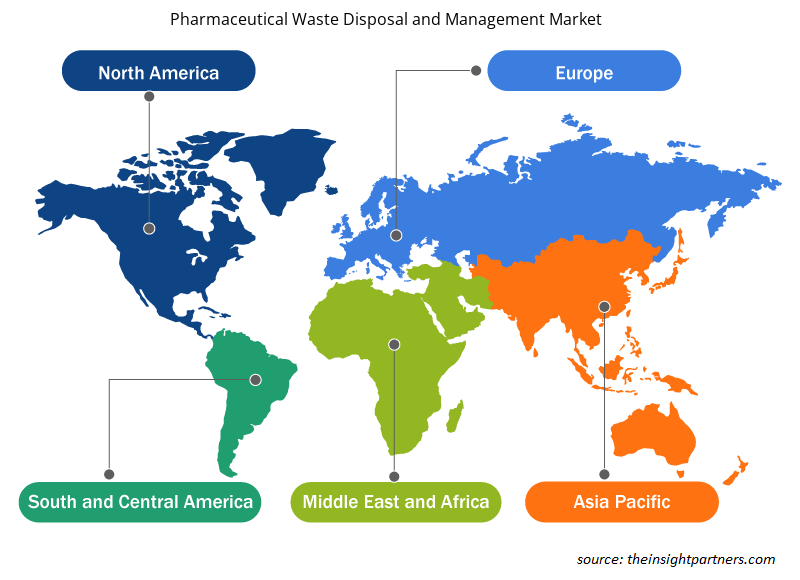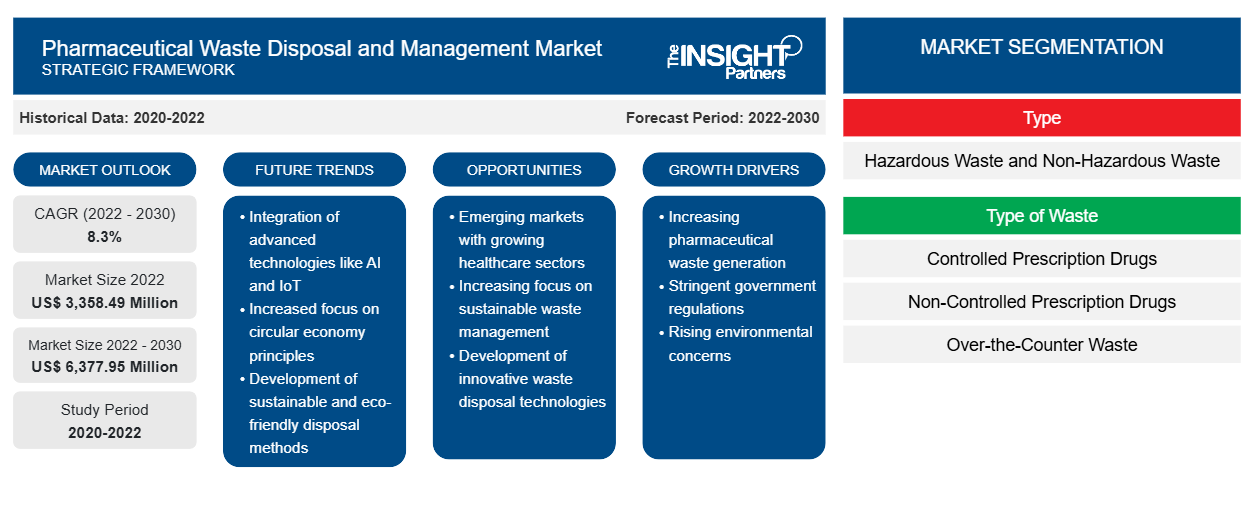[تقرير بحثي] من المتوقع أن ينمو سوق التخلص من النفايات الدوائية وإدارتها من 3،358.49 مليون دولار أمريكي في عام 2022 إلى 6،377.95 مليون دولار أمريكي بحلول عام 2030؛ ومن المتوقع أن يسجل معدل نمو سنوي مركب بنسبة 8.3٪ من عام 2022 إلى عام 2030.
رؤى السوق ووجهة نظر المحلل:
تشمل النفايات الصيدلانية المنتجات غير المستخدمة أو الأدوية التي تجاوزت تاريخ انتهاء الصلاحية. يمكن تصنيف هذه النفايات على أنها خطرة أو غير خطرة بناءً على تركيبها الكيميائي. يعتمد تصنيف الأدوية إلى نفايات صيدلانية أيضًا على ما إذا كانت تشكل خطرًا على الصحة العامة أو البيئة. تشمل النفايات الصيدلانية أيضًا المواد المتبقية من عمليات التصنيع والأدوية التي لا تستلزم وصفة طبية، بالإضافة إلى الأدوية الموصوفة المتبقية بسبب الأسباب المذكورة سابقًا. تشمل العوامل الرئيسية التي تدفع نمو سوق التخلص من النفايات الصيدلانية وإدارتها زيادة المبادرات الحكومية لتعزيز التخلص السليم من النفايات الطبية وزيادة الوعي بشأن النفايات الصيدلانية. ومع ذلك، فإن التكلفة العالية المرتبطة بالتخلص من النفايات الصيدلانية تعيق نمو السوق.
محركات النمو ومعوقاته:
تنتج المستشفيات والعيادات ومؤسسات الرعاية الصحية الأخرى كميات كبيرة من النفايات. وقد زادت الجهود الحكومية التي تركز على تسهيل التخلص المناسب من النفايات الطبية بشكل كبير في السنوات الأخيرة، حيث تشكل الإدارة والتخلص غير المناسبين خطرًا متزايدًا على صحة الإنسان والبيئة. يعد توسع مرافق الرعاية الصحية والزيادة المفاجئة في إنتاج النفايات الطبية عاملين رئيسيين يساهمان في زيادة الطلب على منتجات وخدمات التخلص من النفايات الطبية وإدارتها. اتخذت العديد من الحكومات خطوات للسيطرة على القضايا المرتبطة بالنفايات الطبية من خلال سن قوانين وسياسات تضمن التخلص الآمن والمناسب من النفايات الطبية. تحتاج النفايات الطبية عمومًا إلى التخلص منها بشكل صحيح وتعبئتها ونقلها ومعالجتها وفصلها وفقًا لهذه القواعد. في الولايات المتحدة، صممت وكالات مثل مراكز السيطرة على الأمراض والوقاية منها (CDC) وإدارة السلامة والصحة المهنية (OSHA) وإدارة الغذاء والدواء الأمريكية (FDA) لوائح تتعلق بالنفايات الطبية. العنوان 49 CFR هو لائحة فيدرالية تركز على لوائح النفايات الطبية وعمليات التجميع والتخلص منها ويركز 49 CFR 173.197 على النفايات الطبية المنظمة.
من ناحية أخرى، تشكل التكلفة المرتفعة لعملية التخلص الإجمالية مصدر قلق رئيسي لشركات التخلص من النفايات الصيدلانية وإدارتها، مما يؤثر على بائعي الأدوية ومرافق الرعاية الصحية ومقدمي خدمات إدارة النفايات. ترتبط التكاليف المرتفعة بكل خطوة من خطوات عملية التخلص، بما في ذلك التعبئة والتغليف المناسب للنفايات، والفصل، والنقل، والمعالجة، والأوراق، والامتثال. بالإضافة إلى ذلك، ترجع التكاليف المرتفعة للتخلص من النفايات الصيدلانية إلى تنفيذ بروتوكولات متخصصة، والامتثال التنظيمي، ومتطلبات تقنيات إدارة النفايات المستدامة والأخلاقية.
قم بتخصيص هذا التقرير ليناسب متطلباتك
ستحصل على تخصيص لأي تقرير - مجانًا - بما في ذلك أجزاء من هذا التقرير، أو تحليل على مستوى الدولة، وحزمة بيانات Excel، بالإضافة إلى الاستفادة من العروض والخصومات الرائعة للشركات الناشئة والجامعات
-
احصل على أهم اتجاهات السوق الرئيسية لهذا التقرير.ستتضمن هذه العينة المجانية تحليلاً للبيانات، بدءًا من اتجاهات السوق وحتى التقديرات والتوقعات.
تقسيم التقرير ونطاقه:
يتم تقسيم سوق التخلص من النفايات الصيدلانية وإدارتها العالمية على أساس النوع ونوع النفايات والتطبيق. بناءً على النوع، يتم تقسيم سوق التخلص من النفايات الصيدلانية وإدارتها إلى نفايات خطرة ونفايات غير خطرة. بناءً على نوع النفايات، يتم التمييز بين سوق التخلص من النفايات الصيدلانية وإدارتها إلى أدوية بوصفة طبية خاضعة للرقابة وأدوية بوصفة طبية غير خاضعة للرقابة ونفايات بدون وصفة طبية. بناءً على التطبيق، يتم تقسيم السوق إلى مرافق الرعاية الصحية والصيدليات وشركات الأدوية والتكنولوجيا الحيوية وغيرها. يتم تقسيم سوق التخلص من النفايات الصيدلانية وإدارتها، بناءً على الجغرافيا، إلى أمريكا الشمالية (الولايات المتحدة وكندا والمكسيك) وأوروبا (ألمانيا وفرنسا وإيطاليا والمملكة المتحدة وروسيا وبقية أوروبا) وآسيا والمحيط الهادئ (أستراليا والصين واليابان والهند وكوريا الجنوبية وبقية آسيا والمحيط الهادئ) والشرق الأوسط وأفريقيا (جنوب أفريقيا والمملكة العربية السعودية والإمارات العربية المتحدة وبقية الشرق الأوسط وأفريقيا) وأمريكا الجنوبية والوسطى (البرازيل والأرجنتين وبقية أمريكا الجنوبية والوسطى).
التحليل القطاعي:
ينقسم سوق التخلص من النفايات الصيدلانية وإدارتها، حسب النوع، إلى نفايات خطرة ونفايات غير خطرة. وقد استحوذ قطاع النفايات غير الخطرة على حصة سوقية أكبر في عام 2022. ومع ذلك، من المتوقع أن يسجل قطاع النفايات الخطرة معدل نمو سنوي مركب أعلى خلال الفترة 2022-2030.
يتم تقسيم سوق التخلص من النفايات الصيدلانية وإدارتها، حسب نوع النفايات، إلى أدوية بوصفة طبية خاضعة للرقابة، وأدوية بوصفة طبية غير خاضعة للرقابة، ونفايات بدون وصفة طبية. احتلت شريحة الأدوية بوصفة طبية غير خاضعة للرقابة أكبر حصة في السوق في عام 2022. ومن المتوقع أن تسجل أعلى معدل نمو سنوي مركب من عام 2022 إلى عام 2030.
ينقسم سوق التخلص من النفايات الصيدلانية وإدارتها، حسب التطبيق، إلى مرافق الرعاية الصحية والصيدليات وشركات الأدوية والتكنولوجيا الحيوية وغيرها. في عام 2022، احتل قطاع شركات الأدوية والتكنولوجيا الحيوية الحصة الأكبر في السوق. ومن المتوقع أن يسجل القطاع أعلى معدل نمو سنوي مركب خلال الفترة 2022-2030. CAGR during 2022–2030.
التحليل الإقليمي:
على أساس الجغرافيا، يتم تقسيم سوق التخلص من النفايات الدوائية وإدارتها العالمية إلى خمس مناطق رئيسية هي أمريكا الشمالية وأوروبا وآسيا والمحيط الهادئ وأمريكا الجنوبية والوسطى والشرق الأوسط وأفريقيا.في عام 2022، استحوذت أمريكا الشمالية على أكبر حصة من السوق. يعكس السوق في أمريكا الشمالية مشهدًا معقدًا مدفوعًا باللوائح الصارمة وتقنيات إدارة النفايات المتقدمة والالتزام بالمسؤولية البيئية. تطرح تشريعات مثل قانون الحفاظ على الموارد والاسترداد الأمريكي (RCRA) وقانون حماية البيئة الكندي (CEPA) البروتوكولات الإلزامية للتعامل الآمن والتخلص من النفايات الصيدلانية، تليها مراقبة الالتزام بها، مما يفيد نمو سوق التخلص من النفايات الصيدلانية وإدارتها.RCRA) and the Canadian Environmental Protection Act (CEPA) roll out the mandatory protocols for the safe handling and disposal of pharmaceutical waste, followed by monitoring adherence to the same, which benefits the pharmaceutical waste disposal and management market growth.
تطورات الصناعة والفرص المستقبلية:
فيما يلي قائمة بالمبادرات المختلفة التي اتخذها اللاعبون الرئيسيون العاملون في سوق التخلص من النفايات الدوائية وإدارتها على المستوى العالمي:
- في نوفمبر 2023، وافقت شركة Sumitomo Pharma Co.، Ltd. على التعاون مع شركة ORIX Eco Services Corporation كجزء من مبادرة لإعادة تدوير نفايات التغليف النفطي الناتجة عن عملية التعبئة والتغليف للأدوية الموصوفة التي تصنعها شركة Sumitomo Pharma.
- في مايو 2023، أصبحت شركة ORIX Eco Services أول شركة في اليابان تحصل على ترخيص للتخلص من النفايات الصناعية لإزالة نفايات التغليف المنفوخ والمواد الأخرى. يتم استخدام التغليف المنفوخ لتعبئة الأدوية الموصوفة طبيًا، وقد تم حرق النفايات الناتجة عن هذه الطريقة مسبقًا.
- في أبريل 2022، أعلنت شركة Stericycle Inc عن خط SafeShield الجديد من الحاويات عالية الجودة والموحدة. تم تصميم حاويات النفايات الطبية المضادة للميكروبات هذه خصيصًا لتخزين ونقل النفايات الطبية المنظمة (RMW). توفر هذه الحاويات للعملاء خيارات تخزين أفضل وتصميمًا محسنًا ومستوى إضافيًا من الحماية لمنع نمو الميكروبات على حاويات RMW. بدأت شركة Stericycle سابقًا في طرح الحاويات في أسواق مختارة في الولايات المتحدة بعد التخطيط لطرحها على المستوى الوطني على مراحل.
- في فبراير 2022، استحوذت شركة Republic Services Inc على شركة US Ecology لتوسيع نطاق عملها في جميع أنحاء الولايات المتحدة وكندا. تعد شركة US Ecology من الشركات الرائدة في تقديم الحلول البيئية لمعالجة وإعادة تدوير والتخلص من النفايات الخطرة وغير الخطرة والتخصصية.
- في أكتوبر 2020، استحوذت شركة Waste Management Inc على شركة Advanced Disposal لتوسيع نطاقها. وعلاوة على ذلك، خططت شركة Waste Management للاستفادة من قدرة شركة Advanced Disposal لتلبية احتياجات ما يقرب من 3 ملايين عميل تجاري وصناعي وسكني جديد في الولايات المتحدة.
رؤى إقليمية حول سوق التخلص من النفايات الصيدلانية وإدارتها
لقد قام المحللون في Insight Partners بشرح الاتجاهات والعوامل الإقليمية المؤثرة على سوق التخلص من النفايات الصيدلانية وإدارتها طوال فترة التوقعات بشكل شامل. يناقش هذا القسم أيضًا قطاعات سوق التخلص من النفايات الصيدلانية وإدارتها والجغرافيا في جميع أنحاء أمريكا الشمالية وأوروبا ومنطقة آسيا والمحيط الهادئ والشرق الأوسط وأفريقيا وأمريكا الجنوبية والوسطى.

- احصل على البيانات الإقليمية المحددة لسوق التخلص من النفايات الدوائية وإدارتها
نطاق تقرير سوق التخلص من النفايات الصيدلانية وإدارتها
| سمة التقرير | تفاصيل |
|---|---|
| حجم السوق في عام 2022 | 3,358.49 مليون دولار أمريكي |
| حجم السوق بحلول عام 2030 | 6,377.95 مليون دولار أمريكي |
| معدل النمو السنوي المركب العالمي (2022 - 2030) | 8.3% |
| البيانات التاريخية | 2020-2022 |
| فترة التنبؤ | 2022-2030 |
| القطاعات المغطاة |
حسب النوع
|
| المناطق والدول المغطاة |
أمريكا الشمالية
|
| قادة السوق وملفات تعريف الشركات الرئيسية |
|
كثافة اللاعبين في سوق التخلص من النفايات الصيدلانية وإدارتها: فهم تأثيرها على ديناميكيات الأعمال
يشهد سوق التخلص من النفايات الصيدلانية وإدارتها نموًا سريعًا، مدفوعًا بالطلب المتزايد من المستخدم النهائي بسبب عوامل مثل تفضيلات المستهلكين المتطورة والتقدم التكنولوجي والوعي المتزايد بفوائد المنتج. ومع ارتفاع الطلب، تعمل الشركات على توسيع عروضها والابتكار لتلبية احتياجات المستهلكين والاستفادة من الاتجاهات الناشئة، مما يؤدي إلى زيادة نمو السوق.
تشير كثافة اللاعبين في السوق إلى توزيع الشركات أو المؤسسات العاملة في سوق أو صناعة معينة. وهي تشير إلى عدد المنافسين (اللاعبين في السوق) الموجودين في مساحة سوق معينة نسبة إلى حجمها أو قيمتها السوقية الإجمالية.
الشركات الرئيسية العاملة في سوق التخلص من النفايات الدوائية وإدارتها هي:
- ستيريسايكل، المحدودة
- شركة كلين هاربورز
- شركة دبليو إم للملكية الفكرية القابضة، ذ.م.م
- فيوليا
- حلول النفايات الطبية الحيوية، ذ.م.م.
إخلاء المسؤولية : الشركات المذكورة أعلاه ليست مرتبة بأي ترتيب معين.

- احصل على نظرة عامة على أهم اللاعبين الرئيسيين في سوق التخلص من النفايات الصيدلانية وإدارتها
المنافسة والشركات الرئيسية:
تعد Stericycle Inc وClean Harbors Inc وWM Intellectual Property Holdings LLC وVeolia وBioMedical Waste Solutions LLC وDaniels Sharpsmart Inc وUS Ecology Inc وStryker وCardinal Health وMedWaste Management من بين اللاعبين البارزين الذين يعملون في سوق التخلص من النفايات الصيدلانية وإدارتها. تركز هذه الشركات على تطوير المنتجات الحالية وتوسيع حضورها الجغرافي لتلبية الطلب المتزايد من المستهلكين في جميع أنحاء العالم.
- التحليل التاريخي (سنتان)، سنة الأساس، التوقعات (7 سنوات) مع معدل النمو السنوي المركب
- تحليل PEST و SWOT
- حجم السوق والقيمة / الحجم - عالمي، إقليمي، بلد
- الصناعة والمنافسة
- مجموعة بيانات إكسل
التقارير الحديثة
تقارير ذات صلة
شهادات العملاء
سبب الشراء
- اتخاذ قرارات مدروسة
- فهم ديناميكيات السوق
- تحليل المنافسة
- رؤى العملاء
- توقعات السوق
- تخفيف المخاطر
- التخطيط الاستراتيجي
- مبررات الاستثمار
- تحديد الأسواق الناشئة
- تحسين استراتيجيات التسويق
- تعزيز الكفاءة التشغيلية
- مواكبة التوجهات التنظيمية























 احصل على عينة مجانية ل - سوق التخلص من النفايات الصيدلانية وإدارتها
احصل على عينة مجانية ل - سوق التخلص من النفايات الصيدلانية وإدارتها